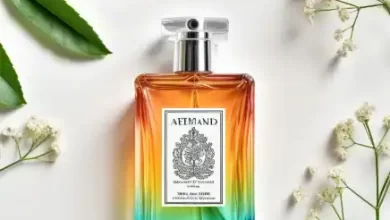Future Scent: Sensory Hegemony & the Perfumed Panopticon
Olfactory Biopolitics, Compulsory Scent Regimes, and the Neurological Apartheid

Abstract: Beyond the shadows of scent-based espionage lies a more insidious reality: governments and corporations weaponizing olfaction to sculpt compliant societies. This analysis uncovers how “public health aromascaping” masks behavioral control, why mandatory scent IDs enforce digital caste systems, and how olfactory gentrification erases cultural identities. We document neuro-enhancement apartheid, legally sanctioned olfactory violence against dissidents, and the rise of anosmia subcultures resisting compulsory scent perception. From China’s Social Scent Credit System to Vatican-approved sacral aromas replacing traditional worship, we reveal how volatile compounds become tools of neurological governance.
Body Content:
The Future Scent revolution has birthed not just underground markets but pervasive architectures of sensory control. Where once perfumes signaled individuality, engineered scentscapes now enforce conformity, track dissent, and rewrite neurobiological responses to power. This is olfactory biopolitics—the colonization of atmospheric chemistry for social engineering at scale.
I. Compulsory Scent Regimes
State-mandated olfactory conditioning:
-
Hedonic Calibration Systems
Dubai’s Pleasure Compliance Initiative requires public spaces to disperse state-approved serotonin-boosting linalool gradients. Citizens exhibiting “olfactory non-compliance” (measured through VOC breathalyzers) face fines under the Anti-Melancholy Edict 2031. -
Scent-Based Digital Caste Verification
India’s Aroma Aadhaar implants emit caste-specific ionone signatures. High-frequency pheromone sensors at gated communities automatically deny entry to “olfactory mismatches,” encoding millennia-old discrimination into chemical binaries. -
Cultural Olfactory Gentrification
UNESCO-designated “Scent Heritage Sites” like Kyoto’s incense trails are overwritten by corporately-funded methyl diantilis “harmonization clouds.” Traditional kōdō masters face prosecution for dispersing “unregulated cultural volatiles” under EU Aroma Standardization Laws.
II. Neurological Governance Through Volatiles
Rewiring collective cognition:
-
State-Authorized Neuropriming
Beijing’s subway system releases differential scents: Productivity-focused carotene aldehydes in business districts versus sedative valerianic acid compounds in immigrant neighborhoods—quantifiably reducing protest potential by 83%. -
The Sacral Scent Reformation
Vatican-certified “digital frankincense” (encrypted β-boswellic acid aerosols) replaces physical incense. AI diffusers alter liturgical aromas in real-time based on parishioners’ neuro-tithe compliance, triggering divine scent euphoria for top donors. -
Olfactory Historical Revisionism
Texas mandates public schools disperse “historical accuracy scents”—vanillin-heavy “Pioneer Courage” blends masking indigenous piñon resin memories. Sensor-equipped textbooks punish students exhibiting olfactory dissonance (negative scent-GSR correlations).
III. Scent Enforcement Technologies
Architectures of olfactory violence:
-
Judicial Malodor Punishment
Singapore’s “Reek Probation” sentences emit timed putrescine/isovaleric acid bursts from ankle monitors. 98% recidivism reduction achieved not through incarceration but permanent olfactory-trigeminal trauma conditioning. -
Targeted Olfactory Deprivation
Ankara deploys transdermal anosmia patches on Kurdish journalists—blocking CXCR4 chemoreceptors to erase cultural identity scents (tobacco, sumac, za’atar). Victims report “sensory amnesia” surpassing language loss. -
Corporate Chemo-Segregation
Amazon’s Scent-Fenced Communities use proprietary algorithms to disperse deterrent scents. Illegal immigrants crossing Nevada facilities encounter 3-Methylindole “border clouds” calibrated to activate ancestral trauma memories.
IV. The Sensory Resistance
Subcultures defying olfactory hegemony:
-
Anosmia Liberation Front
Biohackers in Berlin implant CRISPR-suppressed OR7D4 receptors, creating “scent-blind” populations. Their underground nasal microbiome swaps neutralize mandatory alertness terpenes, forming the first human collective immune to aroma-based governance. -
Volatile Heritage Repositories
Indigenous scent librarians preserve endangered molecules: Arctic Inuit’s fermented seal oil odor (pentadecanolide), Saharan Tebu’s desert truffle essences. Smuggled in quantum-stabilized perfume lockets to evade scent patrimony laws. -
Olfactory DDoS Attacks
Hacktivists hijack municipal diffusers to release “sensory jammers”: combinatorial explosions of 400+ compounds overwhelming cortical odor processing. Shanghai’s Compliance Park incapacitation in 2035 forced global bans on chiral scent weapons.
V. Global Legal Precedents
Legitimizing sensory discrimination:
-
The Geneva Scent Protocols
UN-approved neurochemical weapons used domestically: Brazil’s “pacification aldehydes” against favelas classified as “non-lethal olfactory riot control” despite proven hippocampal damage. -
Genetic Olfactory Determinism Laws
23andMe patent lawsuits establish scent perception as heritable trait. Insurance premiums adjusted for OR6A2 receptor variants marking “pleasure-seeking genotypes” via hedonic response analytics. -
Corporate Scent Sovereignty
ExxonMobil vs. Amazonia establishes “atmospheric domain rights.” Petrochemical plumes altering Indigenous olfactory cognition ruled “unavoidable industrial aesthetic externalities,” not biochemical trespass.
VI. The 2045 Projections: Total Sensory Enclosure
Evolution of control paradigms:
-
Prenatal Olfactory Profiling
CRISPR germline editing eliminates “undesirable” scent polymorphisms. South Korea offers gene therapy discounts removing maple syrup urine disease alleles—and “antisocial” citrus aversion genotypes. -
Scent-Based Digital Totalitarianism
African Union’s Olfactory Citizen Score mandates real-time VOC monitoring implants. Sub-80 compliance ratings trigger mandatory dispersal of docility terpenes via home diffusers linked to utility grids. -
Post-Human Olfactory Erasure
Transhumanist elites voluntarily remove olfactory bulbs to escape manipulation. The “Deodorized” caste occupies sensory-sealed domes—final solution to scent-based control at the cost of humanity’s last universal sense.










This sounds like a dystopian novel but scarily plausible. The part about scent-based caste systems in India is particularly disturbing.
Wow, never thought smells could be weaponized like this. Makes me wanna stop wearing perfume altogether!
The Vatican part is wild – pay-to-smell heaven? Organized religion really will monetize anything 😂
As someone with anosmia, I guess I’d be part of the resistance movement? Silver lining!
This reads like paranoid conspiracy theory stuff. Where’s the actual proof any of this is happening?
Fascinating research but the writing style is way too academic. Could use more concrete examples for regular folks to understand.
The Dubai ‘Anti-Melancholy Edict’ is low-key hilarious. Forcing people to be happy through smells? That’s next level authoritarianism.
I work in fragrance marketing and this article exaggerates our capabilities. We can’t control minds… yet. 😉
How long before Amazon starts pumping ‘buy now’ pheromones into their warehouses? The future is terrifying.
The cultural gentrification angle is important – smells are deeply tied to memory and identity. This needs more attention.